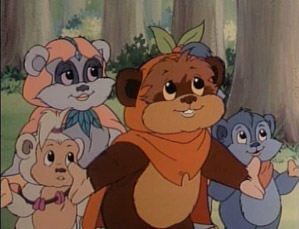Being on the tail end of the “Star Wars” Generation (born in ’78), I loved “Ewoks” — and, among the films, “Return of the Jedi” — before I loved “A New Hope” and “The Empire Strikes Back.” But being a kid, I probably only saw a handful of the episodes when they originally aired in 1985 on Saturday mornings on ABC. Nonetheless, they left an impression, especially those episodes that I could rewatch thanks to my dad taping them onto a Beta cassette.
I remember rewatching (and with many episodes, watching for the first time) “Ewoks” — along with its companion piece, “Droids,” which I’ll review in a future post — when Sci-Fi Channel reran them in 1994, I believe at 5 or 6 a.m. on weekdays. The “E-E-E-E-Ewoks,” certainly more so than school, got me out of bed before sunrise. The best episodes held up then, and they still hold up now, at a time when it’s easy to rediscover them on YouTube. (Unfortunately, a proper DVD release of the series does not seem to be on Lucasfilm’s radar.) Since we’re in the year between “Clone Wars” and “Rebels,” it seems like a perfect time for a rewatch.
Even though “The Clone Wars” has set a much higher standard for “Star Wars” in animation, “Ewoks” features vibrantly colored characters and Endorian creatures, with beautiful tree-lined backgrounds; by many accounts, the work by Canadian company Nelvana — which also did the Boba Fett short in the 1978 “Star Wars Holiday Special” — was a cut above the Saturday-morning standards of the time. The voice work (the Ewoks speak English here, for viewers’ convenience) is top-notch in the first season, as is the music, although the limited themes were repeated from week to week, signifying story staples like “serious threat from Morag,” “carefree day in the village” or “humorously bungling Duloks.”
As I look closer at these first 13 episodes, I realize they clearly break into two groups. Paul Dini, now an animation legend known for his work on “Batman: The Animated Series,” wrote the best episodes, and Bob Carrau wrote the weakest episodes. Carrau deserves credit for expanding the flora and fauna of Endor with his script for “Caravan of Courage,” but his episodes tend to be rote, shallow and lacking in suspense — plus, he kind of uses a “throw it at the wall and see what sticks” approach to creature creation. Dini’s episodes are more layered, funnier and cuter (Malani’s crush on Wicket is giggle-worthy). And in writing the first three episodes, he established the distinct personalities for Wicket, Teebo, Weechee, Willy, Paploo and Chief Chirpa while expanding the roster of girl Ewoks with Kneesaa, Latara and Malani.
While “Ewoks” is far from the pinnacle of televised “Star Wars” now that “The Clone Wars” has changed the game, the series will always have a place in my heart. Here are my rankings of the Season 1 episodes:

1. “The Cries of the Trees” (episode 1, written by Paul Dini) — The first, and still the best. For kids taught about the dangers of forest fires in school, there’s genuine suspense as a blaze approaches the village. Dini’s knack for humor is on display as Wicket’s klutziness while playing Drop the Sack puts him on his aunt’s bad side. We meet the Tinkerbell-like Wisties (or Firefolk), led by Queen Izrina, for the first time since “Caravan of Courage”; surprisingly, they wouldn’t return the rest of the season.
2. “The Haunted Village” (2, Dini) — The second, and still the second-best. This episode is notable for its three different-colored bars of soap. The Duloks covet the “Ewok soap” because it keeps bugs off, but it humorously gets mixed up with Logray’s “magic soap” that turns things invisible, plus a red bar of soap that actually draws bugs to the Duloks.
3. “Asha” (13, Dini) — We meet Kneesaa’s long-lost sister, Asha, who had been living for several snows as a feral woodland Ewok, rescuing animals from Dulok traps. (The Duloks know her as “The Red Ghost.”) Because Asha was orphaned as a Wokling, she speaks primitively, yet is wise when it comes to survival. Ewok woodsman Chukha-Trok makes his cartoon debut here, and it’s the first time the series can be firmly established as taking place before the movies (Chukha-Trok dies in “Caravan of Courage”). Asha returns to the village at episode’s end, but we’ll have to wait for Season 2 to find out if she stays with her family or becomes a female version of the loner Chukha-Trok. One weak spot is the blandly gruff voice work for Asha.
4. “Rampage of the Phlogs” (3, Dini) — Yeah, there’s some humor with the Duloks trying to babysit a giant Phlog youth as a favor to Morag, but it’s the start of Malani’s crush on Wicket (much to his dismay, she wants to pick sunberries and hold hands) that’s the adorable highlight. Also, we learn that Latara has a thing for Teebo, although that won’t be emphasized as much as the season continues.
5. “Wicket’s Wagon” (10, Dini) — This one is notable for featuring a toy I had as a kid, the titular vehicle originally built by Wicket’s ancestor Erpham Warrick to fight off Duloks. Technically, the Ewok Battle Wagon was part of the “Power of the Force” line, as there weren’t any vehicles produced with the “Ewoks” logo on it (and far too few action figures, although I guess I’m partly to blame for the quick cancellation of the line as I never owned any of those). Ewok priestess Kaink, from “Caravan of Courage,” makes her first animated appearance here.
6. “Sunstar vs. Shadowstone” (9, Dini) — This episode is a bit disappointing considering that it answers the major question from early in the series: What is the source of Morag’s hatred for Logray? As it turns out, she basically held him as a slave when he was young and he escaped. So the backstory of her evil is that she’s always been evil. This episode apparently marks the end of the Tulgah Witch’s harassment of the Ewoks, as they turn her into stone.
7. “The Traveling Jindas” (5, Carrau) — Latara joins a traveling circus to show off her flute skills. (To viewers, it seems like she only plays one tune, but that can be explained by budget constraints.) The Jindas call to mind the circus that the Jedi younglings join in Season 5 of “The Clone Wars.” When it’s revealed that the Jindas are notorious for getting lost, the idea of Latara not finding her way home should be frightening to young viewers. But her friends almost immediately find her; like many “Ewoks” episodes, the danger is brief and shallow, perhaps due to the notorious network restrictions on 1980s cartoons.
8. “Blue Harvest” (12, Dini and Sam Wilson) — This “love potion” episode should be funnier than it is. The Phlog girl with a crush on a Dulok, and later Wicket, isn’t half as entertaining as the baby Phlog from episode 3. I think this marks the earliest example of “Blue Harvest” in a title following its use as the fake title for the Arizona shoots on “Return of the Jedi.” A 1990s “Star Wars” fanzine would later be titled “Blue Harvest,” along with a “Family Guy” parody and an arc in the “Dark Times” comic.
9. “To Save Deej” (4, Carrau) — Not surprisingly, Carrau’s first animated entry is a quest story, the same as “Caravan of Courage.” Among the new creatures we meet is a Gupin, who can shapeshift only with the help of others’ imaginations. The voice work on the Gupin is a bit too straightforward. Wicket’s plump brother Willy is in fine form here as he swallows a potion that makes him float like an astronaut in low gravity.
10. “The Tree of Light” (6, Carrau) — There’s some nicely dark animation here as the Ewoks chase the Duloks to the ultimate Soul Tree across a foggy lake of floating islands. Even though “Ewoks” regularly uses magic as a plot device, the idea of one tree causing nature to spring to life across the moon undermines the natural elements of the saga a bit too much for my taste.
11. “The Three Lessons” (11, Carrau) — A weaker riff on the same plot as “To Save Deej” vaguely requires Kneesaa to learn three lessons in order to tame a giant Venus flytrap that’s taking over the village. The tone of the entire episode seems off, with the music editor often confused about when to use the “serious threat,” “carefree day” or “humorously bungling” track.
12. “The Land of the Gupins” (8, Carrau) — Again, here is a quest story that feels too rote. At least Carrau’s Endorian creatures are imaginative, notably the dandelion warriors who throw back their heads to fling thorns at their enemies.
13. “The Curse of the Jindas” (7, Carrau) — Not all of Carrau’s inventions stick, though, and the big hovering rocks that terrorize the Jindas are the low point of Season 1.
What are your memories of Season 1 of “Ewoks?” Do you like these episodes (or at least the good ones) today as much as when you were a kid?
Main image: ABC publicity photo

